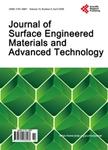Formation of TiO_(2) Nanotube Layer by Anodization of Titanium in Ethylene Glycol-H_(2)O Electrolyte
作者机构:Escola de Engenharia de LorenaUniversidade de Sao PauloLorenaBrazil Faculdade de Engenharia de GuaratinguetaUniversidade Estadual PaulistaGuaratinguetaBrazil
出 版 物:《Journal of Surface Engineered Materials and Advanced Technology》 (表面工程材料与先进技术期刊(英文))
年 卷 期:2014年第4卷第3期
页 面:123-130页
主 题:Nanotubes Titanium Anodization Implants
摘 要:In orthopaedics and orthodontics, the growth of nanotubes of titanium oxide on titanium implants is a promising route for improving the osseointegration. Among the fabrication routes to produce nanotubes, anodization was generally preferred due to its simplicity and low cost. TiO2 nanotubes are formed by the simultaneous anodic reaction and chemical dissolution due to the fluoride species present in the anodization bath. In this work, the formation of TiO2 nanotubes was studied in stirred ethylene glycol-H2O electrolyte (90 - 10 v/v) containing NH4F at room temperature. In order to study the effect of NH4F concentration, voltage and anodization time, and to reduce the number of experiments, a design of experiments (DOE) based on a 2k factorial design with four replicates at the center point was used. The analysis of variance (ANOVA) was used to evaluate the effects of the factors of control and their interactions on the percentage of the titanium surface coated by nanotubes. The dimensions of nanotubes (length and diameter) were also evaluated using field emission gun scanning electron microscopy. The cristallinity and phase composition of the oxide layers was investigated by X-ray diffractometry. The electrochemical behavior of as-received and anodized titanium specimens was studied in Ringer’s solution. The statistical analysis showed that fluoride concentration is the most significant factor. The best condition according to the response surface analysis is the center point (1% NH4F, 20 V, 2 h). The nanotubular oxide layers presented an amorphous structure. Electrochemical tests showed that TiO2 nanotubes coated titanium is less corrosion resistant than as-received titanium.



